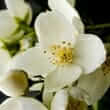Background
- Jasmine (Jasminum spp.) is a woody, perennial climbing plant that is well known for its sweet, highly scented flowers. The flowers and oil are used in perfumes, essential oils, food flavorings, and tea.
- Jasmine flower has been used in aromatherapy for depression, nervousness, coughs, relaxation, and tension. Early studies have shown that jasmine may help with alertness and memory improvement.
References
Natural Standard developed the above evidence-based information based on a thorough systematic review of the available scientific articles. For comprehensive information about alternative and complementary therapies on the professional level, go to . Selected references are listed below.
- Belsito, DV, Fowler, JF, Jr, Sasseville, D, et al. Delayed-type hypersensitivity to fragrance materials in a select North American population. Dermatitis 2006;17(1):23-28.
View Abstract - Chen, Z, Li, Y, Zhao, LC, et al. [A study on the association between tea consumption and stroke]. Zhonghua Liu Xing Bing Xue Za Zhi. 2004;25(8):666-670.
View Abstract - Degel, J and Koster, EP. Odors: implicit memory and performance effects. Chem Senses 1999;24(3):317-325.
View Abstract - Frosch, PJ, Johansen, JD, Menne, T, et al. Further important sensitizers in patients sensitive to fragrances. Contact Dermatitis 2002;47(5):279-287.
View Abstract - lmberger, J, Heuberger, E, Mahrhofer, C, et al. The influence of essential oils on human attention. I: alertness. Chem Senses 2001;26(3):239-245.
View Abstract - Inoue, N, Kuroda, K, Sugimoto, A, et al. Autonomic nervous responses according to preference for the odor of jasmine tea. Biosci Biotechnol Biochem. 2003;67(6):1206-1214.
View Abstract - Ito, Y, Sugimoto, A, Kakuda, T, et al. Identification of potent odorants in Chinese jasmine green tea scented with flowers of Jasminum sambac. J Agric Food Chem. 8-14-2002;50(17):4878-4884.
View Abstract - Ito, Y and Kubota, K. Sensory evaluation of the synergism among odorants present in concentrations below their odor threshold in a Chinese jasmine green tea infusion. Mol Nutr Food Res. 2005;49(1):61-68.
View Abstract - Jain, SK and Agrawal, SC. Fungistatic activity of some perfumes against otomycotic pathogens. Mycoses 2002;45(3-4):88-90.
View Abstract - Kuroda, K, Inoue, N, Ito, Y, et al. Sedative effects of the jasmine tea odor and (R)-(-)-linalool, one of its major odor components, on autonomic nerve activity and mood states. Eur J Appl Physiol 2005;95(2-3):107-114.
View Abstract - Larsen, WG. How to test for fragrance allergy. Cutis 2000;65(1):39-41.
View Abstract - Larsen, W, Nakayama, H, Fischer, T, et al. A study of new fragrance mixtures. Am J Contact Dermat. 1998;9(4):202-206.
View Abstract - Larsen, W, Nakayama, H, Fischer, T, et al. Fragrance contact dermatitis: a worldwide multicenter investigation (Part II). Contact Dermatitis 2001;44(6):344-346.
View Abstract - Nagai, M, Wada, M, Usui, N, et al. Pleasant odors attenuate the blood pressure increase during rhythmic handgrip in humans. Neurosci Lett. 8-11-2000;289(3):227-229.
View Abstract - Wu, YN, Wang, HZ, Li, JS, et al. The inhibitory effect of Chinese tea and its polyphenols on in vitro and in vivo N-nitrosation. Biomed Environ Sci. 1993;6(3):237-258.
View Abstract







